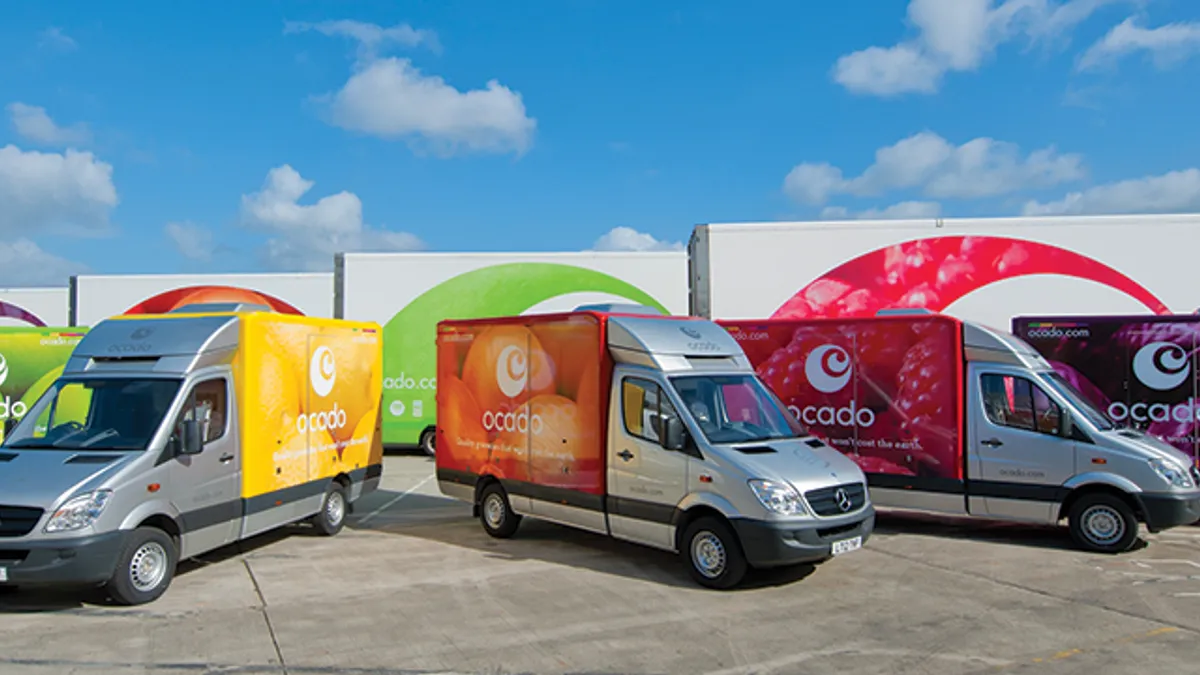Dive Brief:
- Two leading online grocery CEOs offered pointed critiques of brick-and-mortar retailers' efforts in the space during keynote speeches at the Shoptalk conference Monday in Las Vegas. Tim Steiner, CEO of Ocado, pointed out that grocers have moved too slowly and have executed poorly to meet consumer demand. "It's quite simple. The services aren't good enough, the propositions aren't good enough, the food isn't fresh enough and the prices are too high."
- Steiner was also critical of the store-pick model that many retailers offer through third-party providers like Shipt and Instacart, pointing out that Ocado's automated systems and warehouse model can save an hour's time in getting products picked, packed and delivered. Jason Ackerman, chief executive of FreshDirect, which delivers in several northeastern states and the Washington, D.C. area, offered a softer critique. He said that store fulfillment is a natural first step for grocers, but that it's ultimately too expensive and threatens to diminish the store experience for customers.
- Research from the Food Marketing Institute and Nielsen indicate that demand for online grocery shopping is accelerating. In as little as four years, the industry could see $100 billion in sales and have 70% penetration.
Dive Insight:
Both CEO's input should be taken with a grain of salt, since FreshDirect competes with many traditional grocers, while Ocado wants to boost its image in the eyes of potential U.S. retail partners. Still, both grocers belong to a very exclusive club of online grocers that turn a profit — so they know a thing or two about the business.
Independent research and analysis bears out their claims, too. Nielsen and FMI find that consumer demand for online shopping is accelerating, thanks in large part to Amazon's acquisition of Whole Foods and the domino effect of e-commerce acquisitions and tie-ups that followed. As online grocery grows and innovates, more people want to use the service.
Research also shows that, despite their e-commerce expansion, particularly through third-party providers like Instacart and Shipt, grocers lack operational strength and long-term vision. Just 22% of retailers reported a short– and long–term omnichannel strategy, according to interviews and surveys that Nielsen and The Dialogic Group conducted, and which were presented during the Food Marketing Institute's Midwinter Executive Conference in January. When it comes to developing extensive metrics to measure their return on investment with digital strategies, only 5% of retailers say they've established these metrics.
Overall, just 7% of retailers claim they have the culture or skills needed to succeed in omnichannel selling, according to Nielsen and Dialogic findings.
So what does it take to profit and succeed? Ocado has the formula down to a science in the U.K., where its vast, automated warehouses and optimized routing system deliver more than $2 billion worth of groceries every year. Its prices are competitive with major grocers, it boasts 99.7% order accuracy, and more than half of the products it delivers are perishable, bucking the myth that consumers don't want "fresh" online.
But would the model work in the U.S.? Ocado has linked up with several retailers in the U.K., and has recently begun its long-awaited international push — first as the e-commerce provider for Groupe Casino in France, and then for Sobeys in Canada. The company builds large, automated warehouses that promise to fill orders faster and cheaper than any other fulfillment system on the planet. Robots inside the facility dance about, passing within 5 millimeters of one another as they pick products.
Efficiency aside, Ocado's platform requires a deep investment from retailers, in time and money. Sobey's won't make its first online delivery through Ocado until 2020. It's also questionable just how well the automated system will work in a less population-dense U.S., and against rising competition from the likes of Amazon and Walmart. Steiner has said Ocado doesn't need to operate in every market, only the ones where its model makes sense. But cities like New York, Dallas and Chicago are becoming hotbeds of e-grocery activity, and retailers would do their best to make an entry difficult for Ocado.
FreshDirect, meanwhile, offers a model that's already succeeding on American soil. CEO Jason Ackerman said one of the keys to profitability is vertically integrating many of its manufacturing processes. FreshDirect operates its prepared foods commissary, and its operations are directly tied to the company's order management system, meaning workers only make as many meals as they need each day. Ackerman said FreshDirect also oversees its fresh meat and seafood operations, with around 100 butchers preparing orders every day.
FreshDirect does $700 million worth of business in the New York area, and does 70% of its sales in perishable items.
"We vertically integrated manufacturing of products on a made-to-order basis rather than a made-to stock basis, which gave us huge variety and better quality," he said.
Ocado and FreshDirect are online-first grocers that have very different operational models from brick-and-mortar grocers. Still, their focus on execution, efficiency and innovation should serve as inspiration for grocers as they push forward into online selling.









